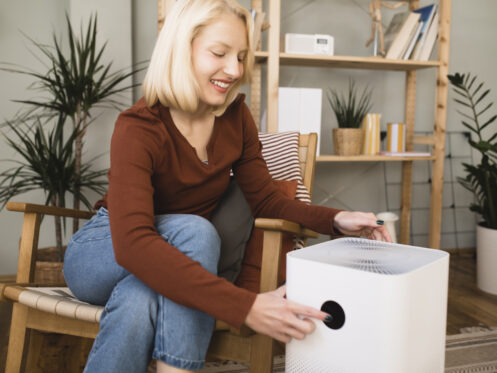Indoor air quality (IAQ) is a big factor in making sure that the environment in your home is as healthy as possible for you and your household. If you spend a significant portion of your time indoors, the quality of the air you breathe can highly affect your overall health. Poor IAQ can come from many sources, including bad ventilation, chemicals, outside pollutants, and molds. Recognizing that bad indoor air quality causes these symptoms is important for promptly improving it. Our team has compiled a list of 13 common symptoms that can show a compromised indoor air quality level. If you have trouble with one or more of these symptoms, our team is readily available to assist you with a solution for your home’s poor indoor air quality.
1. Frequent Headaches
Regular or persistent headaches can be a sign of poor indoor air quality. Pollutants such as carbon monoxide or volatile organic compounds (VOCs) can contribute to headaches. There could even be high levels of dust and allergens in your home, which may cause headaches. Inadequate ventilation can exacerbate the high level of these pollutants, which leads to an environment that triggers headaches. If your headaches are more common in your home, or a particular space in your home, it is important to consider air quality and have our team investigate potential sources to help find a solution and improve the indoor air quality in your home.
2. Dizziness
If you are feeling dizzy or light-headed, it may be the result of exposure to high levels of indoor pollutants. Carbon monoxide is a common indoor pollutant and can accumulate in spaces that are poorly ventilated. If this happens, it can lead to dizziness and other serious how did you. Chemical fumes from cleaning products, paint, or other household items can cause similar symptoms.
3. Fatigue
If you are always tired or lethargic, this can often be caused by poor indoor ventilation, which can reduce oxygen levels and increase indoor pollutants. If air circulation isn’t working properly, pollutants like dust, mold, and chemicals may accumulate leading to feeling tired frequently.
4. Irritated Eyes, Nose, or Throat
Irritation in your eyes, nose, and throat can be because of airborne pollutants present in your home. Common pollutants that affect the eyes, nose, and throat are tobacco or other types of smoke, candles, and mold spores. Chemical vapors from household cleaners, building materials, and paints can also irritate. Identifying and reducing exposure to these pollutants can help alleviate the irritation that you have.
5. Shortness of Breath
Difficulty breathing or experiencing shortness of breath can be a concerning sign of high levels of particulate matter, mold, or chemical pollutants inside your home. Particular matter, such as dust, pollen, and pet dander, can accumulate in the air and cause health issues. If you notice that you only have shortness of breath indoors, it is important to address the problem right away.
6. Allergic Reactions
If you have symptoms like sneezing, coughing, or skin rashes, you may have dust mites, mold, or pet dander in your home resulting in poor indoor air quality. Please call me indoor allergens can become airborne and trigger allergic responses. Dust mites thrive in bedding and upholstery, mold can grow in damp areas, and pet dander can spread throughout the home, causing allergies to worsen.
7. Worsening Asthma
Poor indoor air quality can have a significant impact on asthma. It can worsen the wheezing, coughing, and chest tightness of someone who has asthma. People with asthma who are particularly sensitive to pollutants can find that they have more issues put their asthma while in your home. This is a good indicator that your indoor air quality is low. Common household activities such as cleaning, cooking, and using certain products can also release irritants into the area that affect people with asthma. Ensuring a clean and well-ventilated indoor environment is essential so that respiratory health and asthma symptoms are well cared for.
8. Persistant Cough
If you or someone in your family has a continuous cough, this may be because of various airborne irritants or pollutants. These irritants can inflame the respiratory tract, leading to a chronic cough that persists as long as exposure continues. Dust can accumulate from everyday activities, which can exacerbate the cough.
9. Sinus Congestion
Chronic sinus congestion or sinusitis can result from prolonged exposure to indoor air pollutants or allergens. These irritants can inflame the nasal passages, leading to persistent congestion and discomfort. Dust and pollen are common allergens that can circulate indoors and aggravate sinus conditions. Additionally, chemical pollutants from household products can contribute to the inflammation of sinuses.
10. Nausea
Feeling nauseous or experiencing gastrointestinal issues while you are inside your home can be because of exposure to certain pollutants like VOCs or mold toxins. VOCs can affect people in many different ways. While some people may get dizzy or have a headache, others can get nauseous. Not only is it important to seek medical care if you experience nausea from something that you believe is inside your home, important to make sure that your home is safe as soon as possible. Alleviating poor indoor air quality is one of the best ways to start to feel better if it is your home that is causing the nausea.
11. Skin Irritation
Rashes, dry skin, and itching can be because of indoor pollutants. Pollutants such as pet dander, smoke, and dust can irritate the skin and even an allergic reaction. Some chemicals may also be in your home’s air that can cause rashes and dry skin. If you notice that you have a heightened reaction on your skin while in your home, it is probably because of poor indoor air quality.
12. Unpleasant Odors
Persistent unpleasant smells, such as musty or chemical odors, may be because of underlying issues with indoor air quality. Musty odors typically signal mold or mildew growth, which thrive in damp and humid conditions and can release spores into the air, which may potentially lead to respiratory issues and allergic reactions. You may also smell food odors for longer than you should, indicating that there is poor ventilation in your home.
Improving ventilation is important to combat persistent unpleasant odors. Our team can help ensure that your home has adequate airflow and disperse and dilute pollutants, making the indoor environment for your home healthier. Regular maintenance, cleaning, and replacing filters regularly are a great way to help prevent the reoccurrence of these odors and have a comfortable living space.
13. Increased Dust Accumulation
If there is a noticeable increase in dust accumulation, this can be a sign of poor indoor air quality. Dust is tiny particles that include skin cells, pollen, pet dander, and other pollutants. When ventilation is inadequate or your air filtration system is not effective, these particles can accumulate rapidly on surfaces throughout your home. This cannot only harm your health but can also cause you to need to clean more often. If you notice that you have to dust more than usual, this is a good indicator of poor indoor air quality.
At Aace's Heating, Air Conditioning & Swamp Coolers in Victorville, CA, we provide indoor air quality, swamp coolers, and whole-house fans for homes in the area. Our friendly team also provides AC installation, mini-split services, and heating installation. Contact Aace's Heating, Air Conditioning & Swamp Coolers for more information today!






